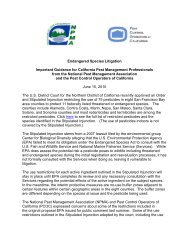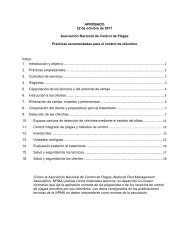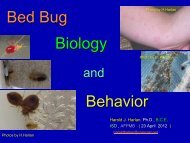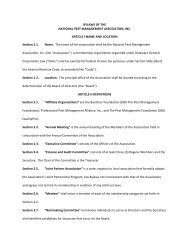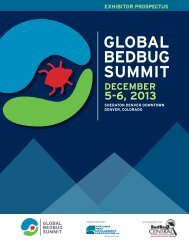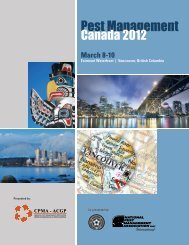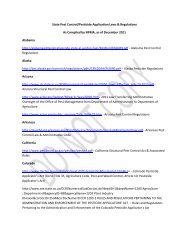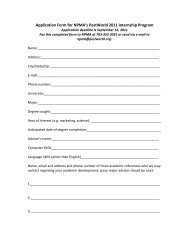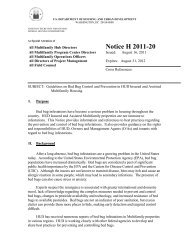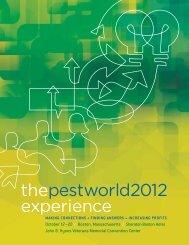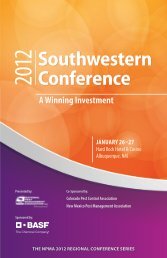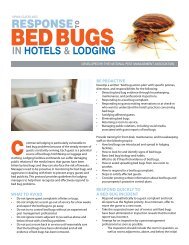Pest Management Standards For Food Plants - National Pest ...
Pest Management Standards For Food Plants - National Pest ...
Pest Management Standards For Food Plants - National Pest ...
You also want an ePaper? Increase the reach of your titles
YUMPU automatically turns print PDFs into web optimized ePapers that Google loves.
Appendix B: <strong>Food</strong> and Drug Administration, HHS § 110.3<br />
(b) Cleanliness. All persons working in direct contact with food, food-contact surfaces,<br />
and food-packaging materials shall conform to hygienic practices while on duty to the<br />
extent necessary to protect against contamination of food. The methods for maintaining<br />
cleanliness include, but are not limited to:<br />
(1) Wearing outer garments suitable to the operation in a manner that protects against<br />
the contamination of food, food-contact surfaces, or food-packaging materials.<br />
(2) Maintaining adequate personal cleanliness.<br />
(3) Washing hands thoroughly (and sanitizing if necessary to protect against contamination<br />
with undesirable microorganisms) in an adequate hand-washing facility before starting<br />
work, after each absence from the work<br />
<strong>Food</strong> and Drug Administration, HHS § 110.20<br />
station, and at any other time when the hands may have become soiled or contaminated.<br />
(4) Removing all unsecured jewelry and other objects that might fall into food, equipment,<br />
or containers, and removing hand jewelry that cannot be adequately sanitized<br />
during periods in which food is manipulated by hand. If such hand jewelry cannot be<br />
removed, it may be covered by material which can be maintained in an intact, clean, and<br />
sanitary condition and which effectively protects against the contamination by these objects<br />
of the food, food-contact surfaces, or food-packaging materials.<br />
(5) Maintaining gloves, if they are used in food handling, in an intact, clean, and sanitary<br />
condition. The gloves should be of an impermeable material.<br />
(6) Wearing, where appropriate, in an effective manner, hair nets, headbands, caps,<br />
beard covers, or other effective hair restraints.<br />
(7) Storing clothing or other personal belongings in areas other than where food is<br />
exposed or where equipment or utensils are washed.<br />
(8) Confining the following to areas other than where food may be exposed or where<br />
equipment or utensils are washed: eating food, chewing gum, drinking beverages, or using<br />
tobacco.<br />
(9) Taking any other necessary precautions to protect against contamination of food,<br />
food-contact surfaces, or food-packaging materials with microorganisms or foreign substances<br />
including, but not limited to, perspiration, hair, cosmetics, tobacco, chemicals, and<br />
medicines applied to the skin.<br />
(c) Education and training. Personnel responsible for identifying sanitation failures or<br />
food contamination should have a background of education or experience, or a combination<br />
thereof, to provide a level of competency necessary for production of clean and safe<br />
food. <strong>Food</strong> handlers and supervisors should receive appropriate training in proper food<br />
handling techniques and food-protection principles and should be informed of the danger<br />
of poor personal hygiene and insanitary practices.<br />
(d) Supervision. Responsibility for assuring compliance by all personnel with all requirements<br />
of this part shall be clearly assigned to competent supervisory personnel.<br />
[51 FR 24475, June 19, 1986, as amended at 54 FR 24892, June 12, 1989]<br />
§ 110.19 Exclusions.<br />
(a) The following operations are not subject to this part: Establishments engaged solely<br />
in the harvesting, storage, or distribution of one or more ``raw agricultural commodities,’’<br />
as defined in section 201(r) of the act, which are ordinarily cleaned, prepared, treated, or<br />
otherwise processed before being marketed to the consuming public.<br />
(b) FDA, however, will issue special regulations if it is necessary to cover these excluded<br />
operations.<br />
Subpart B — Buildings and Facilities<br />
§ 110.20 Plant and grounds.<br />
(a) Grounds. The grounds about a food plant under the control of the operator shall be<br />
kept in a condition that will protect against the contamination of food. The methods for<br />
adequate maintenance of grounds include, but are not limited to:<br />
(1) Properly storing equipment, removing litter and waste, and cutting weeds or grass<br />
within the immediate vicinity of the plant buildings or structures that may constitute an<br />
attractant, breeding place, or harborage for pests.<br />
B<br />
APPENDIX<br />
29



